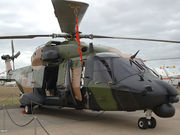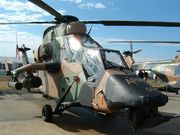Australian Army
| Australian Army | |
|---|---|
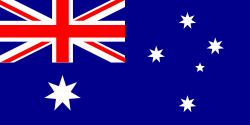 |
|
| Active | 1 March 1901 – Present |
| Country | Australia |
| Type | Army |
| Size | 27,828 (Regular) 17,064 (Active Reserve) 12,496 (Standby Reserve) |
| Part of | Australian Defence Force |
| Engagements | Second Boer War World War I World War II Korean War Malayan Emergency Indonesian Confrontation Vietnam War War in Somalia East Timor Regional Assistance Mission to Solomon Islands War in Afghanistan Iraq War |
| Commanders | |
| Chief of the Defence Force | ACM Angus Houston AC, AFC |
| Chief of Army | LTGEN Ken Gillespie AO, DSC, CSM |
| Notable commanders |
FM William Birdwood, 1st Baron Birdwood GEN Sir John Monash GEN Sir Henry Chauvel FM Sir Thomas Blamey GEN Peter Cosgrove |
| Insignia | |
| Australian Army badge | |
The Australian Army is Australia's military land force. It is part of the Australian Defence Force (ADF) along with the Royal Australian Navy and the Royal Australian Air Force. While the Chief of Defence (CDF) commands the Australian Defence Force (ADF), the Army is commanded by the Chief of Army (CA). The CA is therefore subordinate to the CDF, but is also directly responsible to the Minister for Defence.[1] Although Australian soldiers have been involved in a number of minor and major conflicts throughout its history, only in World War II has Australian territory come under direct attack.
The Australian Army's mission is to provide a potent, versatile, and updated Army to promote the security of Australia and protect its people.[2][3][4] Further, the Army's key doctrine publication, The Fundamentals of Land Warfare, states that "the Army’s mission is to win the land battle".[5]
Contents |
History
.jpg)
The history of the Australian Army can be divided into two periods:
- 1901–1947, when limits were set on the size of the Regular Army, the vast majority of peacetime soldiers were in Reserve units of the Citizens Military Force (also known as the CMF or Militia), and Australian Imperial Forces were formed to serve overseas, and
- Post-1947, when a standing peacetime regular infantry force was formed and the CMF (known as the Army Reserve after 1980) began to decline in importance.
During its history the Australian Army has fought a large number of major wars, including: Second Boer War (1899–1902), First World War (1914–1918), the Second World War (1939–1945), Korea War (1950–1953), Malayan Emergency (1950–1960), Indonesia-Malaysia Confrontation (1962–1966), Vietnam War (1962–1973) and more recently in Afghanistan (2001 – Present) and Iraq (2003 – Present). However, since 1947 it has also been involved in many peacekeeping operations, usually under the auspices of the United Nations. The largest one began in 1999 in East Timor. Other notable operations include peacekeeping on Bougainville and in the Solomon Islands, which are still ongoing to this day. Humanitarian relief after 2004 Indian Ocean earthquake in Aceh Province, Indonesia, Operation Sumatra Assist, ended on 24 March 2005.[6]
.jpg)
Current deployments
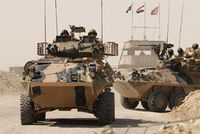
The Australian Army currently has significant forces deployed on four major operations:[7]
- Operation Catalyst – Australia's commitment to the Coalition forces in Iraq.
- Operation Kruger – Australia's embassy security detachment which provides security protection and escort for staff at the Australian Embassy in Baghdad, and consists of 100 personnel.
- Operation Slipper – Australia's commitment to the War on Terror. The army contribution is primarily concentrated in Afghanistan:
- Mentoring and Reconstruction Task Force; attached to the Dutch-led Provincial Reconstruction Team in Oruzgan Province, this consists of engineers protected by a reinforced infantry company.
- Operation Astute – Approximately 400 Australian personnel and 140 New Zealand personnel are deployed to East Timor as part of the ISF that is working in support of the Government of East Timor and the United Nations to maintain peace and stability.
- Operation Anode – Australia's commitment to the Regional Assistance Mission to Solomon Islands (RAMSI) Consists of a 160-strong Combined Task Force. The ADF contributes around 80 to 120 troops to this Task Force
- Operation Mazurka – Australia's commitment to Multinational Force and Observers (MFO). From 1982–1986, the RAAF provided rotary wing aviation support. Since 1994 the Australian Army has maintained a presence within the organisation. Currently 25 personnel rotate twice a year, being employed in key HQ, operations and logistics positions.
- Operation Paladin – is the Army's longest ongoing operation, where Australian personnel have served since 1956. Operation Paladin is Australia's contribution to the UN Truce Supervision Organisation that was established in 1948 to supervise the truce agreed at the conclusion of the first Arab/Israeli War.
Current organisation
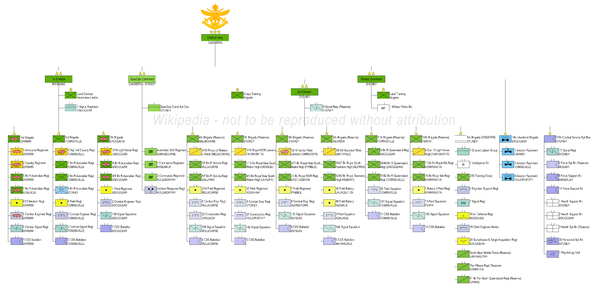
1st division takes responsibility for the majority of the regular army, while 2nd Division under the command of Forces Command is the main home defence formation, containing Army Reserve units. Only the 1st Division's headquarters is deployable, however, as the 2nd Division's headquarters only performs administrative functions. The Australian Army has not deployed a divisional sized formation since 1945 and does not expect to do so in the future.[8]
1st Division
1st Division is currently based on regular Army Brigades containing a total of 10 deployable Battlegroups
- 1 Brigade – a Mechanised Brigade based in Darwin.
-
- 1 Armoured Regiment (M1A1 Abrams AIM)
- 1 Armoured Reconnaissance Regiment (ASLAV)
- 2 Mechanised Infantry Battalions (M113AS3/4)
- 1 Medium Artillery Regiment (M198 Howitzer)
- 1 Reconnaissance Squadron (Aviation) (Tiger ARH)
- 3 Brigade – a Light Infantry Brigade based in Townsville
-
- 1 Armoured Personnel Carrier Squadron (Bushmaster IMV)
- 3 Light Infantry Battalions
- 1 Field Artillery Regiment (L119 Howitzer)
- 7 Brigade – a Motorised Brigade based in Brisbane.
-
- 1 Armoured Cavalry Regiment (ASLAV)
- 2 Motorised Infantry Battalions (Bushmaster IMV)
- 1 Field Artillery Regiment (L119 Howitzer)
Special Forces
Special Operations Command is a command formation of equal status to the other commands in the ADF, but is drawn exclusively from the Army. It is a brigade sized formation responsible for all of Australia's special forces assets.
-
- 1 Special Air Service Regiment
- 2 Commando Regiments
- 1 Incident Response Regiment
- 1 Aviation Squadron (Blackhawk)
Forces Command
2nd Division
2nd Division is this is the main home defence formation, consisting mainly of reserve forces, with its HQ located in Sydney. It is divided into 6 brigades.
- 4 Brigade – based in Victoria.
- 5 Brigade – based in New South Wales.
- 8 Brigade – based in New South Wales.
- 9 Brigade – based in South Australia and Tasmania.
- 11 Brigade – based in Queensland.
- 13 Brigade – based in Western Australia.
Colours, standards and guidons
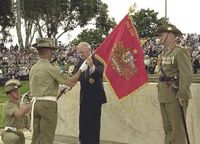
Infantry, and some other combat units of the Australian Army carry flags called the Queen's colour and the Regimental Colour, known as 'the Colours'. Armoured units carry Guidons – flags smaller than Colours traditionally carried by Cavalry, Lancer, Light Horse and Mounted Infantry units. Artillery units' Guns are considered to be their Colours, and on parade are provided with the same respect. Non-combat units (combat service support corps) do not have Colours, as Colours are battle flags and so are only available to combat units. As a substitute, many have Standards or Banners.[9] Units awarded battle honours have them emblazoned on their Colours, Standards and Guidons. They are a link to the Unit's past and a memorial to the fallen. Artillery do not have Battle Honours; their single Honour is "Ubique" which means "Everywhere".
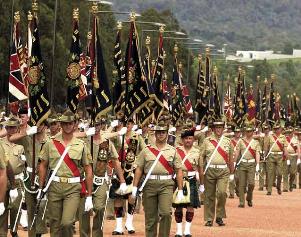
The Army is the guardian of the National Flag and as such, unlike the Royal Australian Air Force, does not have a flag or Colours. The Army, instead, has a banner, known as the Army Banner. To commemorate the centenary of the Army, the Governor General Sir William Deane, presented the Army with a new Banner at a parade in front of the Australian War Memorial on 10 March 2001. The Banner was presented to the Regimental Sergeant Major of the Army, WO1 Peter Rosemond.
The Army banner bears the Australian Coat of Arms on the obverse, with the dates "1901–2001" in gold in the upper hoist. The reverse bears the 'rising sun' badge of the Australian Army, flanked by seven campaign honours on small gold-edged scrolls: South Africa, World War I, World War II, Korea, Malaya-Borneo, South Vietnam, and Peacekeeping. The banner is trimmed with gold fringe, has gold and crimson cords and tassels, and is mounted on a pike with the usual British royal crest finial.[10]
Personnel
Strength
In the 2008–09 financial year the Army had an average strength of 44,892 personnel, including 27,828 permanent (regular) and 17,064 active reservists (part-time).[11] In addition there are another 12,496 members of the Standby Reserve.[12] The regular Army is targeted to expand to 30,500 personnel by 2016.[13]
Rank and insignia
The ranks of the Australian Army are based on the ranks of the British Army, and carry mostly the same actual insignia. For officers the ranks are identical except for the shoulder title "Australia". The Non-Commissioned Officer insignia are the same up until Warrant Officer ranks, where they are stylised for Australia (e.g. using the Australian, rather than the British coat of arms).
Current recruiting issues
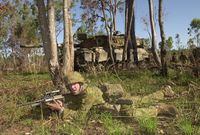
On 24 August 2006, the then Prime Minister John Howard announced a requirement for an extra 2,600 soldiers for the Australian Army, in addition to a previously announced increase of 1,500. Recent remarks of low morale in the Army, a high desire to leave the armed forces for civilian careers amongst serving soldiers, low unemployment figures for school-leavers and university graduates, as well as general opposition for Australian soldiers serving in Iraq have resulted in the Army falling short of its recruiting expectations. The new campaign, which included the raising of two new infantry battalions ready for overseas deployment by 2010, reportedly cost $A10 billion. The first of these new battalions, to be operational by 2008, was formed be the de-amalgamation of 5/7 RAR into the reformed 5th Battalion and 7th Battalion, Royal Australian Regiment. The second battalion to be re-raised was the 8th/9th Battalion, Royal Australian Regiment. Prime Minister John Howard cited causes for this requirement as the threat of unstable, possibly terrorist harbouring states in Australia’s immediate region:
"Look at what happened in East Timor. Look at what happened in the Solomon Islands. Think back a few years to Fiji. Think of Vanuatu. Think of the inherently unstable situation in Papua New Guinea".[14]
The statement drew opposition from the Papua New Guinean Prime Minister, Sir Michael Somare, who claimed on 25 August 2006 that an expansion of the Australian Army would actually be in response to its forces already deployed in the Middle East, and not for the possibility of threat from its Pacific neighbours.
On 15 October 2006 the then Defence minister Brendan Nelson announced that the Army will be implementing a new 'try before you buy' recruitment system, reducing the Initial Minimum Period of Service (IMPS) from four years to one year for enlisted soldiers. Aimed at school leavers, this system is designed to reduce the impact of joining the army for recruits entering the work force, making the option of military service more attractive. This is known as the "ADF Gap Year", playing on the term of "gap year" where school-leavers take a year off before going to University to study.[15] Foreign nationals with prior military service have also been permitted to join the Australian Army.[16]
Concern that the plan also may result in an overall reduction in the fitness, medical and age restrictions placed on applicants, in order to 'modernise' the restrictions and also assist in boosting numbers drew criticism of these plans within some veteran's organisations. Along with this announcement, arguments for more and better equipment were advanced, with speculation of a possible increase in the numbers of M113 APCs, Bushmaster IMV and M1A1 Abrams tanks being acquired. Indeed in late 2008 additional Bushmasters and upgraded M113s were ordered for the Australian Army in significant numbers.[17]
By mid-2007, following an extensive multi-million dollar advertising campaign seeking recruits, there is now a reversal of the situation with high enlistment numbers (exceeding the governments target by 1,004 persons) but due to the lack of available and adequate training facilities and personnel more than 85 percent of applicants wait for between 35 days and 6 months to start their training, resulting in dropouts in recruits during this period.[18] In response, plans to create a second recruit-training battalion have been put forward, but that may take years to eventuate, if at all.[19]
Equipment
| Small arms | F88 Austeyr (service rifle), F89 Minimi (support weapon), Browning Hi-Power (sidearm), MAG-58 (general purpose machine gun) |
| Special forces | M4 carbine, Heckler & Koch USP, SR-25, F89 Minimi, MP5 |
| Main Battle Tanks | 59 M1A1 Abrams A.I.M. |
| Infantry fighting vehicles | 257 ASLAV |
| Armoured Personnel Carriers | 766 M113 (431 being upgraded to M113AS3/4 standard, balance to be mothballed and used to support upgrade program) |
| Infantry Mobility Vehicles | 289 Bushmaster IMVs (737 ordered)[17] |
| Land Rovers | 5000 FFRs 5000 GS |
| Artillery | 112 L118/L119 105 mm Hamel Guns, 120 M2A2 105 mm Howitzer, 36 M198 155 mm Howitzer, 36 RBS-70 ground to air missile launchers.[20][21] |
| Radar | AN/TPQ-36 Firefinder radar, AMSTAR Ground Surveliance RADAR |
| Unmanned Aerial Vehicles | Insitu Aerosonde and Elbit Systems Skylark |
| Aircraft | Origin | Type | Versions | Number in service[22] | Notes | |
|---|---|---|---|---|---|---|
| Helicopters | ||||||
| OH-58 Kiowa | OH-58A Scout helicopter | 206B | 42 | Built under licence in Australia by Commonwealth Aircraft Corporation. To be replaced by the Eurocopter Tiger. | ||
| Boeing CH-47 Chinook | Transport helicopter | CH-47D | 6 | 7 CH-47F are on order to replace the current CH-47D's. | ||
| Eurocopter Tiger | Attack helicopter | Tiger ARH | 16 | Total of 22 to be delivered. | ||
| Sikorsky S-70 Blackhawk | Utility helicopter | S-70A-9 | 35 | To be eventually replaced by the MRH 90 | ||
| MRH 90 | Utility helicopter | TTH: Tactical Transport Helicopter | 2 | 5 TTH MRH-90 have been accepted by the Defence Materiel Organisation, total of 46 on order (including 6 for Royal Australian Navy) | ||
|
Army bases
The Army's operational headquarters, Land Command, is located at Victoria Barracks in Sydney. The Australian Army's three regular brigades are based at Robertson Barracks near Darwin, Lavarack Barracks in Townsville, Queensland and Gallipoli Barracks in Brisbane, Queensland. The Deployable Joint Force Headquarters is also located at Gallipoli Barracks.
Other important Army bases include the Army Aviation Centre near Oakey, Queensland, Holsworthy Barracks near Sydney, Lone Pine Barracks in Singleton, New South Wales and Woodside Barracks near Adelaide, South Australia. The SASR is based at Campbell Barracks Swanbourne, a suburb of Perth, Western Australia.
Puckapunyal north of Melbourne, Victoria houses the Australian Army's Combined Arms Training Centre, Land Warfare Development Centre, and three of the five principal Combat Arms schools. Further barracks include Steele Barracks in Sydney, Keswick Barracks in Adelaide, and Irwin Barracks at Karrakatta in Perth. Dozens of Army Reserve depots are located across Australia.
See also
- Australian Defence Force ranks and insignia
- List of Australian military memorials
- Conscription in Australia
- Australian military slang
Notes
- ↑ Defence Act (1903)
- ↑ [1]
- ↑ "Australian Defence Force (ADF) – australia.gov.au". Australia.gov.au. http://www.australia.gov.au/398. Retrieved 2009-11-29.
- ↑ "Australia in Brief – Department of Foreign Affairs and Trade". Dfat.gov.au. http://www.dfat.gov.au/aib/defence_security.html. Retrieved 2009-11-29.
- ↑ Australian Army. "The Fundamentals of Land Warfare". http://www.defence.gov.au/army/LWD1/index.htm. Retrieved 2007-04-11.
- ↑ "Australian War Memorial Official History of Peacekeeping, Humanitarian and Post-Cold War Operations". http://www.awm.gov.au/peacekeeping/. Retrieved 4 April 2009.
- ↑ http://www.defence.gov.au/globalops.cfm
- ↑ David Horner (2001). Making the Australian Defence Force. Oxford University Press, Melbourne. ISBN 0195541170. Page 195.
- ↑ "National Flags, Military Flags, & Queens and Regimental Colours". Digger History. http://www.diggerhistory.info/pages-flags/0-flag-cat-index.htm. Retrieved 2007-04-03.
- ↑ "Army Flags (Australia)". Flags of the World. http://www.crwflags.com/fotw/flags/au%5Earmy.html. Retrieved 2007-04-03.
- ↑ Australian Department of Defence (2009). Page 196.
- ↑ Australian National Audit Office 2009.
- ↑ Ward, Stephen (13 May 2010). "Promotion is Army's future". Army News (Australian Department of Defence): p. 21.
- ↑ "PM Announces Army Expansion". www.abc.net.au. http://www.abc.net.au/cgi-bin/common/printfriendly.pl?http://www.abc.net.au/pm/content/2006/s1723437.htm. Retrieved 2006-08-24.
- ↑ "Doorstop Interview – Brendan Nelson". Department of Defence. http://www.defence.gov.au/minister/2006/GAP.doc. Retrieved 2009-03-14.
- ↑ Australian Army Recruiting – Overseas Applicants
- ↑ 17.0 17.1 The Hon. Joel Fitzgibbon MP, Minister for Defence (2008-10-29). "Contract Signed for Additional Bushmasters". Press release. http://www.minister.defence.gov.au/Fitzgibbontpl.cfm?CurrentId=8381. Retrieved 2008-10-29.
- ↑ "Australian Army Rise Up Recruitment". The Inspiration Room Daily. http://theinspirationroom.com/daily/2007/australian-army-rise-up-recruitment. Retrieved 2007-04-10.
- ↑ "Diggers in hole as boom recruits go untrained". news.com.au. http://www.news.com.au/story/0,23599,21778691-421,00.html. Retrieved 2007-05-23.
- ↑ "Australian Military Strength". Globalfirepower.org. http://www.globalfirepower.com/country-military-strength-detail.asp?country_id=Australia. Retrieved 2008-03-14.
- ↑ 57 M777A2 and an as yet unannounced self-propelled gun are set to replace both 105 mm and 155 mm systems used by the regular army artillery.
- ↑ "2009 World Military Aircraft Inventory – Australia". Aviation Week & Space Technology. 2009-01-26. http://www.aviationweek.com/aw/sourcebook/content.jsp?channelName=pro&story=xml/sourcebook_xml/2009/01/26/AW_01_26_2009_p0240-112924-07.xml&headline=World%20Military%20Aircraft%20Inventory%20-%20Australia. Retrieved 2010-02-25.
References
- Australian National Audit Office (2009). Army Reserve Forces. Audit Report No.31 2008–09. Canberra: Australian National Audit Office. ISBN 10367632. http://www.anao.gov.au/uploads/documents/2008-09_Audit_Report_No.31.pdf.
- Australian Department of Defence (2009). Defence Annual Report 2008-09. Canberra: Defence Publishing Service. ISBN 9780642297143. http://www.defence.gov.au/budget/08-09/dar/index.htm.
External links
 Media related to Australian Army at Wikimedia Commons
Media related to Australian Army at Wikimedia Commons- Australian Army website
|
||||||||||||||||||

